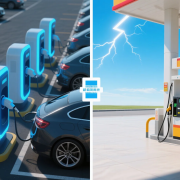Panorama of charging pile development in Mexico in 2025: Accelerating layout to meet the turning point of electrification
The latest statistics and forecasts of charging pile scale in 2025
According to the latest industry white paper released by the Mexican Association for the Promotion of Electric Vehicles (AMME), as of the first quarter of 2025, the number of public charging piles in operation in Mexico has exceeded 12,000, and is expected to reach 15,000-16,500 by the end of the year, achieving an average annual growth rate of about 40%. This figure includes:
Fast charging piles (DC): the proportion increased to 35% (about 4,200)
Ordinary charging piles (AC): 65% (about 7,800)
V3 supercharging stations: Tesla and other companies have built 320 new supercharging stations with a capacity of more than 250kW
It is worth noting that in 2025, the Mexican charging pile market will be dominated by “public-private partnerships”, with private enterprise investment accounting for 78%, of which the “Red de Carga Pública” project in which the national power company CFE participated contributed 22% of the infrastructure.
Policy-driven and new development trends
The New Energy Transportation Act is fully implemented
The Electric Transportation Promotion Act, which will take effect in January 2025, clearly stipulates:
New commercial buildings must reserve 10% of parking spaces for charging facilities
At least 4 fast charging piles are required for every 50 kilometers of highways
The charging service fee implements a market regulation mechanism
Cross-departmental collaboration is strengthened
The Ministry of Energy and the Ministry of Tourism jointly launched the “Green Tourism Corridor Plan”, and built 480 charging points in 12 tourist destinations such as Cancun and Los Cabos, of which 30% are integrated photovoltaic storage and charging facilities.
Market structure and technological innovation
Three major charging networks have been formed
Tesla Supercharger: covering 85% of states, with 210 stations
Shell Recharge: 580 charging piles deployed based on the gas station network
CFE Carga: a government-led affordable charging network with a unit price 15-20% lower than the market
Significant technology upgrade
Huawei Digital Energy cooperates with local companies to deploy 600V liquid-cooled super charging piles, which can last 300 kilometers after charging for 5 minutes
Blockchain technology is applied to the charging pile payment system to achieve cross-border settlement
The number of solar carport charging stations increased by 200% year-on-year
Analysis of regional development differences
Leading regions:
Nuevo León (Monterrey): 8.7 charging piles per 10,000 people
Mexico City: The first “15-minute charging circle” was built
Baja California Sur: The density of charging piles in tourist areas is the highest in the country
Regions to be developed:
The coverage rate in southern regions such as Chiapas and Oaxaca is still lower than the national average
Rural areas have the problem of “last mile” charging
Carlos, director of the Transportation Research Center of the National Polytechnic Institute of Mexico Mendoza pointed out: “In 2025, we saw a real turning point – the ratio of the number of charging piles to the number of electric vehicles reached a reasonable level of 1:8 for the first time, but it will take 3-5 years for regional balanced development.”
User behavior and market response
AMME consumer survey shows:
78% of electric car owners choose to charge during the low-peak period at night
The average utilization rate of fast charging piles climbed to 61%
The median waiting time for charging dropped to 22 minutes
“Charging anxiety is turning into charging habits,” said Elena, Director of Electric Mobility at BMW Mexico Rodríguez said, “Our dealer network charging station usage data shows that the average single charging time for users in 2025 is 18% shorter than in 2024.”
Challenges and opportunities coexist
Existing problems:
The payment systems of different operators are not yet fully interoperable
The grid carrying capacity is facing challenges in local areas
The average response time for charging station maintenance is still 48 hours
Emerging opportunities:
The electrification of the used car market has created community charging needs
The electrification of logistics companies’ fleets has brought opportunities for the construction of dedicated charging stations
The economic benefits of integrated photovoltaic storage and charging solutions are prominent in areas with high electricity prices
2025-2030 Outlook
The latest roadmap of the Ministry of Energy shows:
The “Rural Coverage Plan” for charging infrastructure will be implemented in 2026
The deployment of charging networks on all federal highways will be completed by 2027
The total number of charging stations in 2030 is targeted to be 55,000
“2025 is the year for improving the quality of electric travel infrastructure construction in Mexico,” said Energy Minister Rocío Nahle emphasized at a recent new energy forum that “we must not only increase the number of charging piles, but also build an intelligent, efficient and inclusive charging ecosystem.”
As Asian companies such as China’s BYD and South Korea’s LG have successively put into production in charging equipment factories in Mexico, localized production will further reduce construction costs, and a new round of charging network expansion is expected to usher in a climax in the second half of 2025. It is generally believed in the industry that Mexico is playing an increasingly important leading role in the electric vehicle revolution in Latin America.





Leave a Reply
Want to join the discussion?Feel free to contribute!